
Check the age you'll get the State Pension in the UK.
Current age
Your date of birth

Day
Month
Year
These are estimates based on your age and prices of things going up in future. Learn more below.
Based on your age, here’s how much you’ll likely need for retirement.

Not sure where and how to start saving? A popular method for boosting your pension pot (alongside a work pension) is setting up your own pension (a personal pension).
You’ll also get a massive 25% bonus from the government (and more if you pay 40% and 45% tax), and your money will grow tax-free!
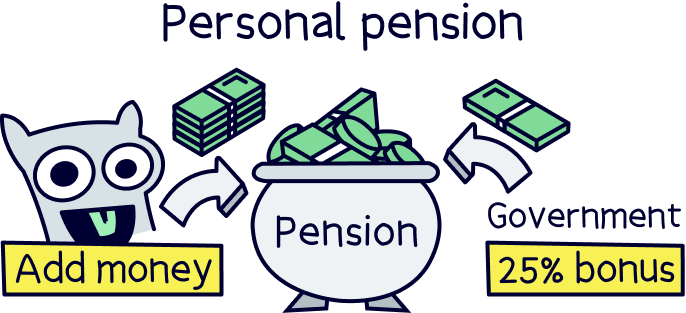
Not sure where to get one? Our top pick is PensionBee, it’s easy to use, low cost and a great record of growing pensions over time. You’ll also get £50 added to your pension for free with Nuts About Money. Alternatively, compare all the top providers.
Visit PensionBee¹Learn more with our PensionBee review. Capital at risk.
Use our pension calculator to plan your retirement savings and get on track – it’s easy to use and takes less than a minute.
Currently, the State Pension age is 66 years old. However, this is changing to 67 soon and later to 68.
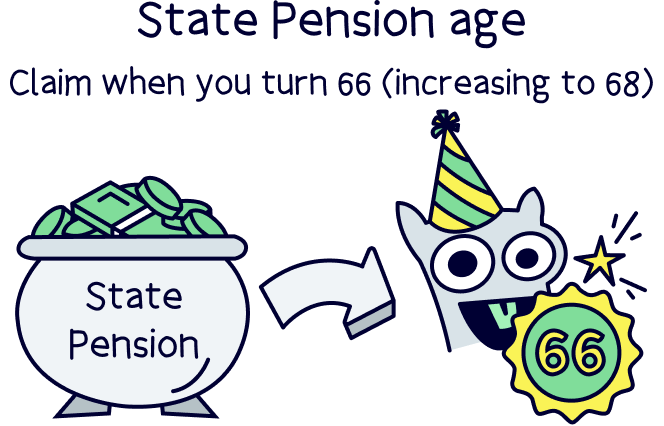
Nuts About Money tip: if you’re not quite sure what the State Pension is, we’ve explained it below.
The change to 67 will be complete by 5th March 2028, and it will work in a somewhat complicated way, which is intended to make it fair, rather than a complete switch from 66 to 67 in one day, which would mean some people born in that year will lose out by a whole year.
So, for those born in the tax year of 1960/1961 (the tax year runs from 6th April to 5th April the following year), the State Pension age will step up by one month, every month, until the end of the tax year.
Here’s how it works…
If you are born on 6th April 1960, instead of your State Pension age being 66, it will be 66 and 1 month, so it will be 6th May 2026.
However, if you were both on 6th May 1960, your State Pension age will be 66 and 2 months. So your State Pension age will be 6th July 2026.
Make sense? And this goes up all the way up for 12 months until it reaches 67, which would be for those born on or after 6th March 1961.
This works in the same way as the change to 67, so steps up by one month every month – but is of course much later, and will affect those born in the tax year 1971/72 (and continue as 68 for those after).
So, if your date of birth is 6th April 1977, your State Pension age will be 67 and 1 month.
For those born on 6th May 1977, your State Pension age will be 67 and 2 months.
And this happens all the way up until it reaches 68 for those born on 6th March 1978 or onwards.
We’ve aimed to give you as much information as possible about your future, and so instead of using the current State Pension figure, we’ve estimated what yours will be when you retire.
The State Pension will always increase each year, as it’s written into law. It will change depending on which one of these 3 things is the highest:
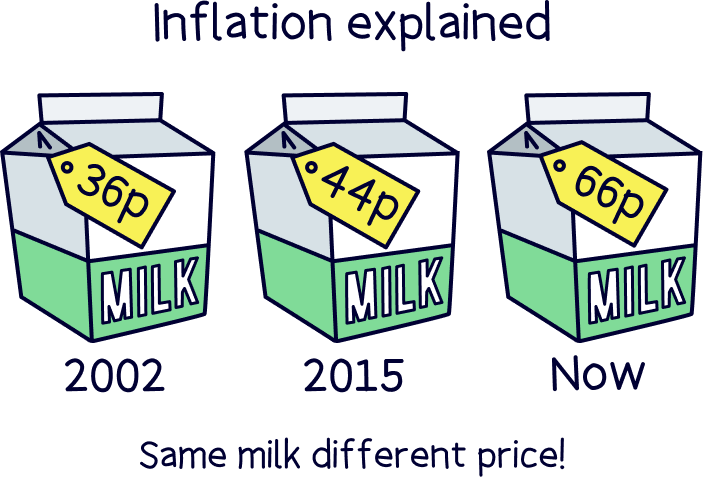
This is called the ‘triple lock’.
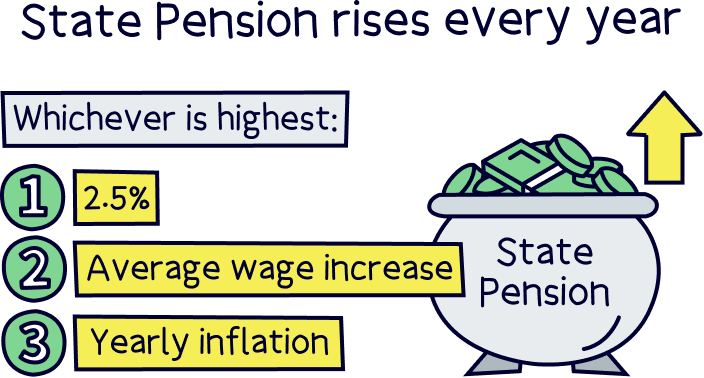
We’ve used 2.5% to forecast your State Pension, as this is the minimum it can change by.
Hopefully, it will rise by more, but it’s best not to plan for that. And the law can always be changed in the future.
The State Pension is the government pension. It’s what you get to support yourself in retirement from the government.
The full State Pension is currently £230.25 per week, which is £11,973 per year.
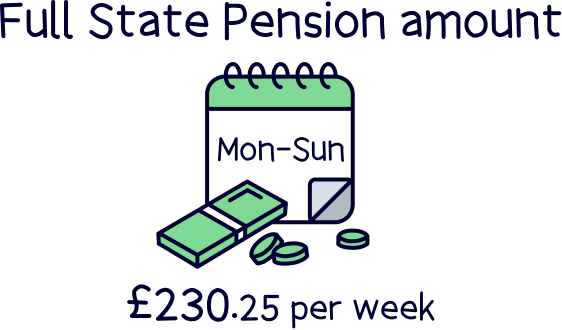
It’s not a lot – and it’s likely not enough to live on just by itself. And even as it increases in the future, it rises in order to keep up with the price of things like food increasing over time (called inflation), not to give pensioners more spending money (sorry!).
It’s currently, and likely always will be, lower than the recommended retirement income, which is currently £13,400 – and far below the recommended comfortable retirement income of £43,900.
These recommendations are based on the Retirement Living Standards, which we’ll run through just below.
In order to receive the State Pension, you’ll need to have paid at least 10 years worth of National Insurance contributions over your lifetime – however to get the full amount, you’ll need to have paid 35 years worth.
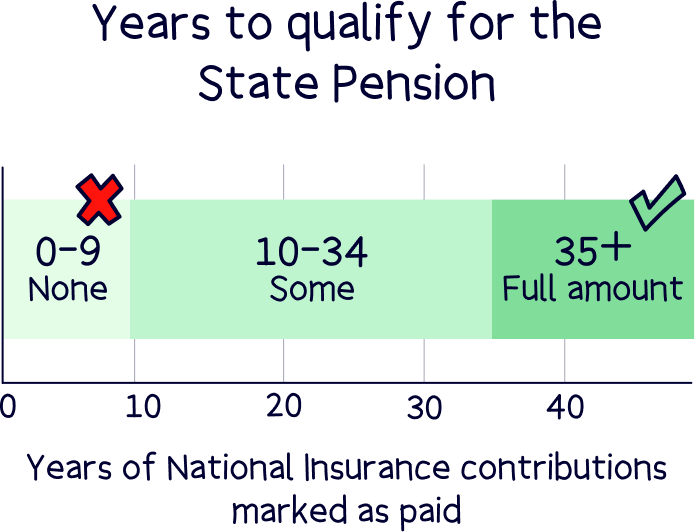
Note: these years are called ‘qualifying’ years.
If you’re employed, your National Insurance contributions will come out of your pay automatically. If you’re self-employed, you’ll pay them at the end of your tax year.
Nuts About Money tip: if you’re nearing retirement, but not sure if you have enough qualifying years, use the government’s State Pension forecast tool, where you’ll see your own record, and can make top ups for the last 6 years.
Did the comfortable retirement income amount scare you? It probably should, and unfortunately it is fairly accurate.
We’ve used the current recommended retirement incomes (minimum, moderate and comfortable), and forecast them into the future by the rate of inflation. Using a figure recommended for future planning, 2.5%, set by the Financial Conduct Authority (FCA).
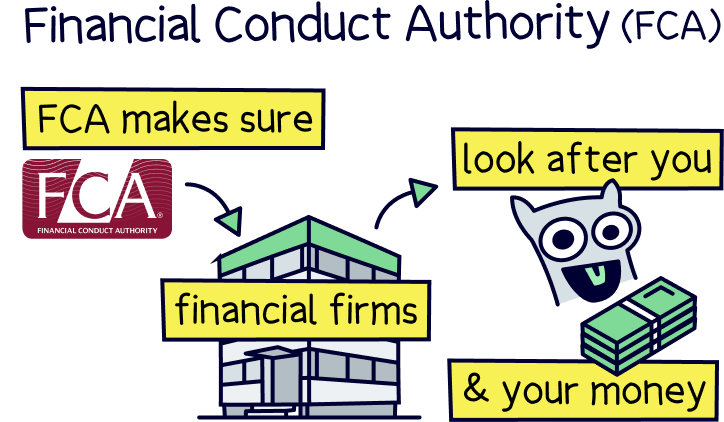
Note: inflation is the price of things like food and fuel going up every year, which happens continually over time.
To help you plan your future and your retirement income, the Pensions and Lifetime Savings Association have put together the Retirement Living Standards.
These are three categories (minimum, moderate and comfortable), for how much you’ll likely need in retirement to suit the lifestyle you’d like.
They estimate how much you will spend in retirement, not what your income will be. For this reason, we've planned a higher income to account for tax you’ll pay in order to have the appropriate amount.
No housing costs are included (e.g. rent or mortgage). It’s assumed you’ll have paid off your mortgage by the time you retire – so if you think you’ll have housing costs, you’ll need to increase the forecast retirement income further.
Note: they are reviewed each year, and so rise each year.
This is how much you’ll need to cover the essentials, such as a small budget for food and household bills. You won’t be able to afford a car, and there’s not much for things like new clothes or presents for friends and family.
Today, this is £13,400 per year for a single person and £21,600 for a couple.
This is improved financial security, with all the typical bills covered. There’s a bit more for food, and some spare to eat out once per month. You can also run a small cheap car (at least 3 years old), and be able to replace it every 7 years.
There’s a bit for presents for friends and family (e.g. Christmas and birthdays), and you’ll be able to afford a cheap two week holiday in Europe each year.
Today, this is £31,700 per year for a single person, and £43,900 for a couple.
This gives you a lot more financial freedom, and you’ll have all the essentials covered to a reasonable standard (e.g. a bit more for food each week). However, it’s still not a luxurious life.
You’ll be able to replace your car every 5 years, and a budget for home improvements (around £600 per year). And enough for a more expensive two week holiday in Europe, and three long weekends in the UK per year.
Today, this is £43,900 per year for a single person, and £60,600 for a couple.
In order to reach those retirement income levels we’ve estimated, we’ve also worked out how much you’ll need in your private pension pot, in addition to receiving the State Pension.
A private pension is a pension separate to the government pension, for instance, one from work, or one you set up yourself – we’ll cover this more below.
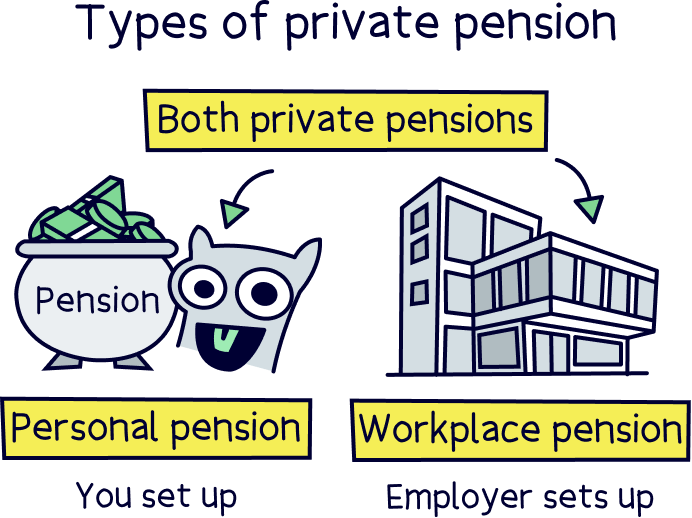
To learn more about how we got to these figures, head over to our pension calculator, where you can get a more personalised recommendation.
Yikes. The amount you need to have in your private pension is all a bit scary isn’t it? That's why planning for your own retirement is essential, whatever age you are – even if you’re just a few years out from retirement, or 18.
You cannot rely on the State Pension to provide you with everything you’ll need in retirement, you really do need a private pension alongside it.
A private pension is one that’s in your name (private to you), you decide how much to save into it, and ultimately when to withdraw from it and retire.
You’re able to save into them tax-free, and you can start withdrawing from them at age 55 (57 from 2028), although we typically recommend leaving it until you do actually retire (to increase your retirement income).
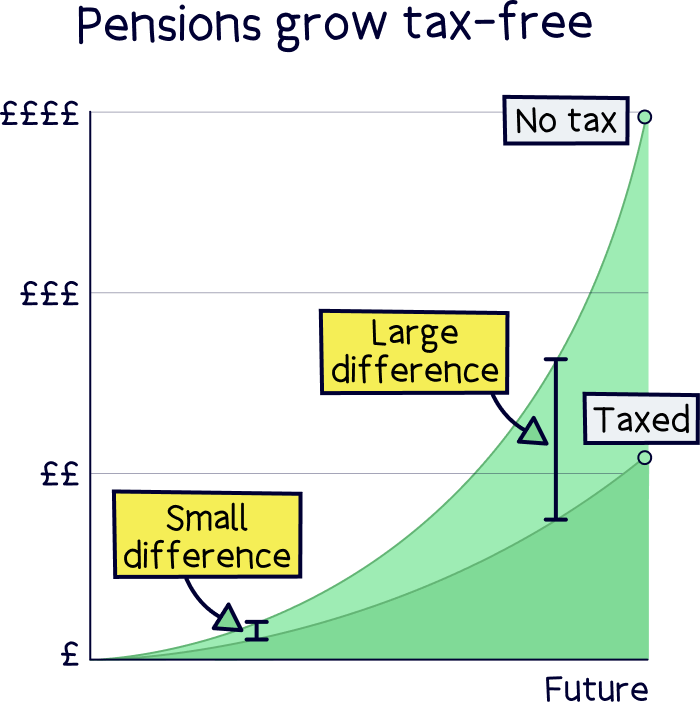
If you’re employed, you’ll likely have one already from work, and if you move to a new job, they’ll normally set one up for you as part of the auto-enrolment scheme. You then pay a portion of your salary straight into your pension (it comes out of your pay). This is called a workplace pension.
There’s also a personal pension, which is what you’ll need if you’re self-employed, but they’re also a great way to boost your total pension pot in addition to a workplace pension (if you’re employed).
Let’s run through both types.
This is what your employer will set up for you, and if you pay in at least 5% of your salary per year, your employer has to pay in 3% too! (By law). Pretty great right?
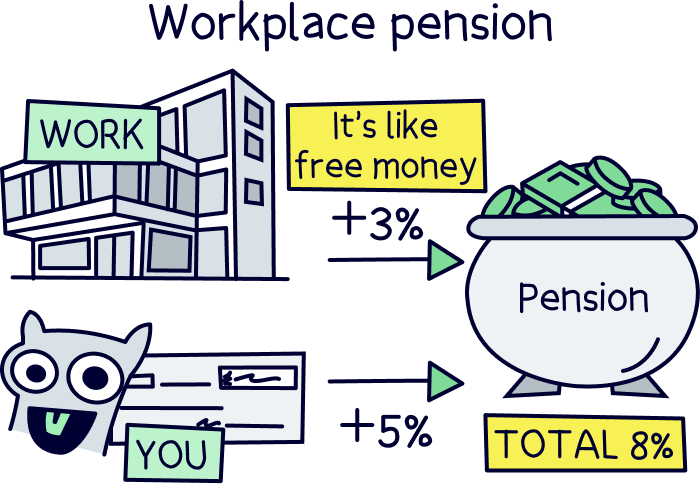
The downside is you don’t get to pick which pension provider to use, your employer will choose one (and some aren’t that great).
A personal pension is one that you set up yourself, you get to pick the pension provider, which pension plan to use (such as ethical investments excluding fossil fuel companies), or even your own investments (with a self-invested personal pension (SIPP)).
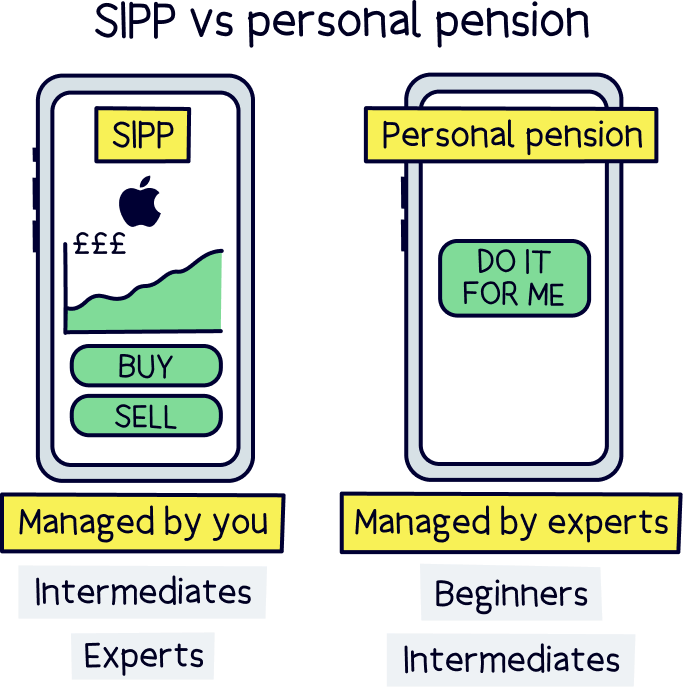
It has all the same tax saving benefits as a work pension, it just works a bit differently – instead of your money going into your pension pot tax-free, when you add cash, the government will give you a 25% bonus, added directly to your pension pot.
This is to refund the 20% tax rate you've paid on your income. And if you’ve paid 40% or 45% tax on your income, you can claim this back too – which you can do on a Self Assessment tax return. Technically, it’s called tax relief.
They’re a great option to build a comfortable retirement alongside a work pension – where you can use your work pension to get the free cash from your employer (the 3% when you save 5%), and then make further contributions into a personal pension where you have much more control and freedom over your pension.

You can also transfer old pensions from old jobs over to your new pension, to keep all your pension cash where you want it, and won’t forget about it when the time comes to retire (which happens more than you might think!).
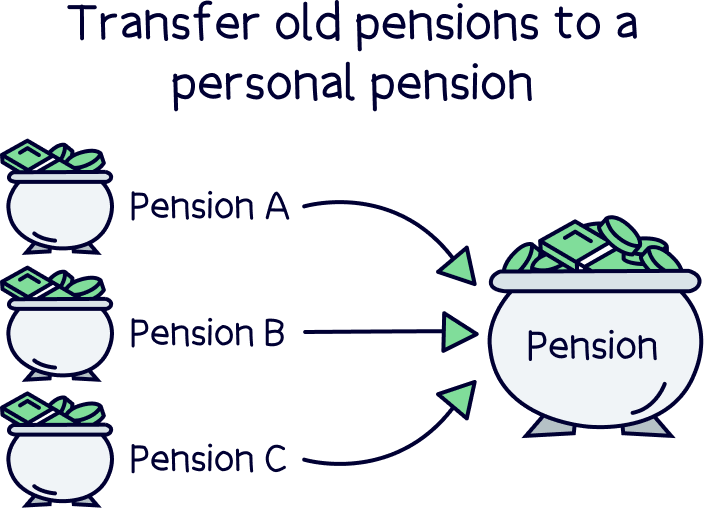
Note: you can’t transfer your current work pension. Just ones from old jobs.
So, you can pick a provider of your choice, that could potentially grow your pension more, have things like lower fees, and better customer service. The choice is all yours. Learn more with our guide to the top personal pensions.
If you don’t get near the full State Pension amount in retirement, and don’t have any other income, there is a benefit from the government called Pension Credit.
The Pension Credit qualifying age is the same as your State Pension age.
This can boost your income up to just under the State Pension amount (or more if you’re disabled or a carer), so you’ll have a bit more to live on.
It can also open the door to other benefits such as help with housing costs (both via a mortgage or renting), and things like cold weather payments and a warm home discount (to help with the heating bills), a free TV licence, and a reduction in council tax (and more).
Nuts About Money tip: learn more with our guide to Pension Credit.
It really is super important to save for your retirement, although we know it can be very difficult. Even saving a small bit each much will really add up over time and build that pension pot and retirement income.
The sooner you start saving more, the bigger your retirement income will be – and your future self will be thanking you (a lot!).
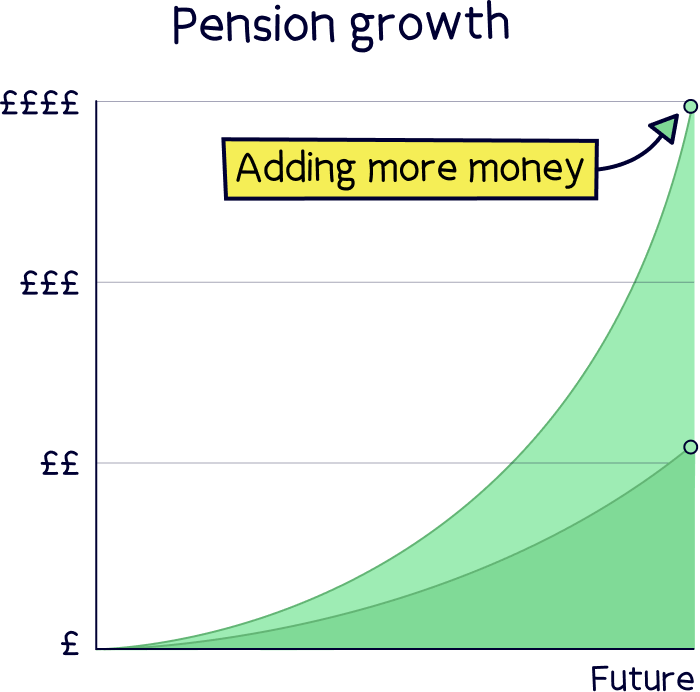
Those figures above might be scary, but over time, they’ll become more normal – we’re planning years ahead, and your money will grow and grow inside your pension pot, as long as you’re able to contribute enough to it (start now!). We recommend a regular savings amount that’s affordable – and just set and forget it (well, check occasionally that you’re still on track).
You can work out how much you might want to be saving per month with our advanced pension calculator (it’s easy to use).
And if you’re saving into a work pension already, consider making more contributions into a personal pension, where you have lots more control over your pension provider, and get all the same tax benefits.
That means your money can be growing in the way that you want (e.g. ethically), and with a provider that you’re happy with (e.g. great customer service, and things like a great mobile app).
You can also move your personal pension to another provider whenever you like too, so can always be with a provider you’re happy with. And you can move old pensions over if you’d like (so you won’t forget about them).
Anyway, we won’t keep banging on about saving more, but if that’s interesting to you, here’s our top picks for personal pensions.
PensionBee will contribute £50 to your pension when you open a PensionBee account.